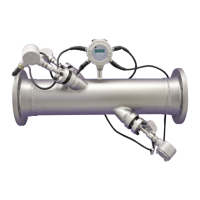DigitalFlow™ XMT868i Startup Guide 39
Chapter 2. Initial Setup
2.4.3 Entering Pipe Parameters
Enter the transducer and pipe parameters using the PIPE submenu. While following the programming instructions,
refer to Figure 15 on page 46.
1. From the
Channel PROGRAM menu, scroll to the PIPE option and press [Enter].
2. The first prompt asks for the Transducer Number.
• For a standard transducer, enter the number engraved on the transducer head in the right pane, and press
[Enter].
• If there is no number engraved on the transducer head, press the right arrow key to scroll to the Special
option, enter an assigned number (from 91 to 99), and press
[Enter].
IMPORTANT: Special transducers, which have no engraved number on the head, are rarely used. Examine the
transducer head carefully for a number.
The menu now varies, depending on your selection in step 2:
• If you entered the number for a standard clamp-on transducer, proceed to the Pipe Material prompt in step 4.
• If you entered the number for a standard wetted transducer, proceed to the Pipe OD prompt in step 5.
• If you entered the number for a special transducer, proceed to step 3 below.
2.4.3a Special Transducers
Note: For special transducers, GE will supply a transducer data sheet with programming information.
3. For special transducers:
a. The program first asks for the Wedge Type. Press the appropriate transducer type (Rayleigh clamp-on,
shear clamp-on, or wetted).
Note: GE will supply the information required for steps b through f with the transducers.
b. Press the appropriate Frequency (from 500 kHz to 5 MHz).
c. Enter the Time Delay (Tw) value supplied by GE and press
[Enter].
Note: If you have selected a special wetted transducer, the program now goes to step 5. But if you have selected a
clamp-on transducer, three more prompts appear.
d. Enter the Wedge Angle of the transducer (the angle of the ultrasonic transmission, in degrees) and press
[Enter].
e. Enter the Wedge Temperature and press
[Enter].
f. Enter the Wedge Soundspeed and press
[Enter].

